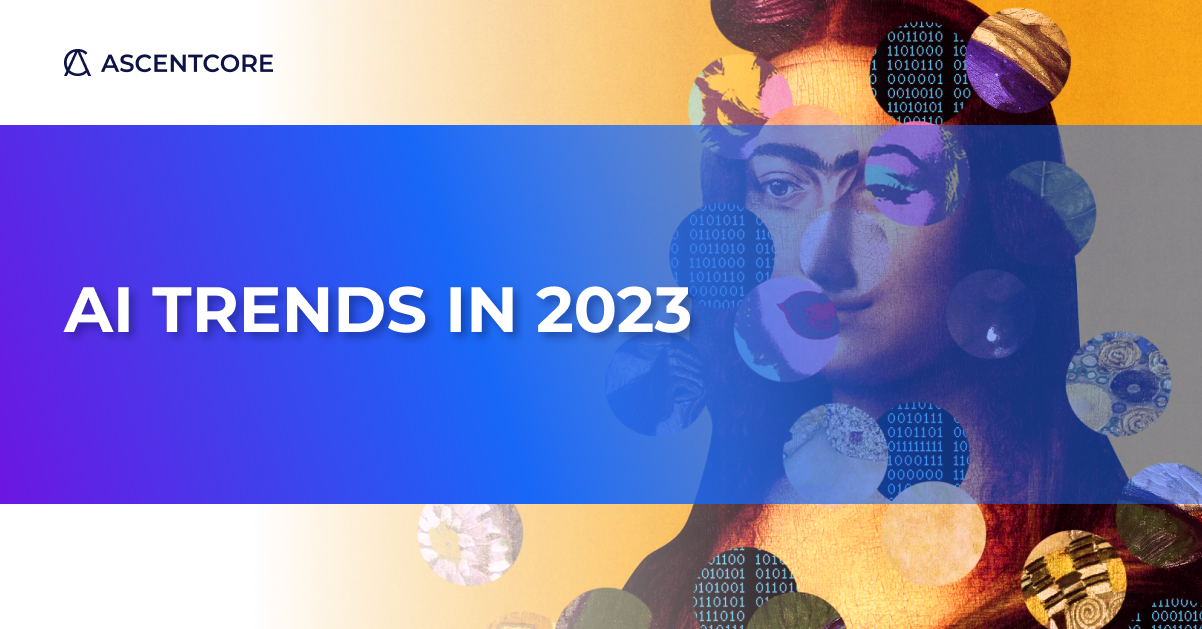Over the past decade, Artificial Intelligence (AI) moved from research labs to industries used in a wide variety of applications and last year made a breakthrough in the world of creativity. The year 2022 could be declared the Generative AI year, but this was just the beginning of introducing AI into the creative process. The creativity of AI was introduced to two industries that have nothing in common but required human creativity to reach an end goal: Software Development and Art. The adoption of Copilot into the popular development IDEs and winning first place at the Colorado State Fair fine arts competition of an art created by an AI technology attracted the attention of both adopters and investors.
Here are some key Artificial Intelligence trends that will take shape in 2023 as predicted by AscentCore CTO, Cornel Stefanache:
Generative AI
The current state of the generative approaches produces impressive results, but the human factor still has little control over the output. Some attempts were made to uncover the factors that contribute to the decisional results and offer the user a fair amount of control over correcting the results, but there are a lot of improvements to be made. Furthermore, having little control over the output raises ethical concerns, such as generating offensive content or using a hundred million images without the creator’s consent. Generative AI has been around for years. But in the last 18 months, the language models that power most tools in the field have become stunningly good at creating art, writing and making other content with a human-like touch. The year ended with the appearance of ChatGPT, and it caused a ripple in the world with implications for almost every industry. The future for this kind of technology is the adoption of it for areas such as Customer Support, Sales and Marketing, Education, Healthcare, Recruitment, Travel, Entertainment and Legal Advice.
Responsible AI
The development of AI is creating new opportunities to improve lives and aid industries in making giant leaps in shorter times. This new technology has to gain more traction in adoption in many fields. Still, at the same time, it raises further questions about the systems’ fairness, interpretability, privacy and security. Biased datasets will generate biased models, and the developers of generative models are required to build complex filters, usually, other AI models, that can evaluate whether the result is offensive or not. This issue introduces a major blocker in the accelerated adoption, and the solution might be a focus point for the year to come. Performing open surgery to pre-trained models and removing the biased factors will allow the models to learn from everything and deliver unbiased content. Some benchmarks and technologies were developed to tackle XAI. Still, they usually challenge important common-sense topics such as gender and political biases and leave the other subjective issues to escape the decision making algorithm. The adoption of generative models such as Chat GPT into human interface industries must ensure the identification and removal of any biased decisions.
Sustainable AI
According to Our World In Data: The world faces two energy problems: most of our energy production still produces greenhouse gas emissions, and hundreds of millions lack access to energy entirely. AI contributes to the first problem, and contributes a lot. A paper published in 2020 called: “Energy and Policy Considerations for Modern Deep Learning Research” found that training a single deep-learning model can result in the emission of 284,000 kilograms of CO2. Larger models require more power for training. Today the best solution to improving the quality of the model results is to increase the number of trainable parameters. This approach is not necessarily the most efficient and usually transforms the model into a black box. Some improvements are expected in improving the current technology to reduce the required resources to perform training.
Democratization of AI
Over the past decade, the democratization of AI in the enterprise space has accelerated. Democratization of artificial intelligence means making AI available for all. In other words, open-source datasets and tools developed by companies like Microsoft and Google – which demand less knowledge of AI from the user – are made available, so anyone can build innovative AI software. This has led to the rise of ‘citizen data scientists’. Some improvements were made in this direction with the presence of HuggingFace, and ModelZoo, where people can adopt pre-built/trained models into their technology but still, as of today, creating a tailored AI for an industry need, requires a certain level of expertise in the field.
All in all, 2023 will be another high-growth year for AI. The commercialization of new products and features, strides in access and affordability, and a focus on responsible practices will open up disruptive use cases for the enterprise and beyond. These are exciting times to be in the AI space, and it will be interesting to see how the industry progresses over the next 12 months.



